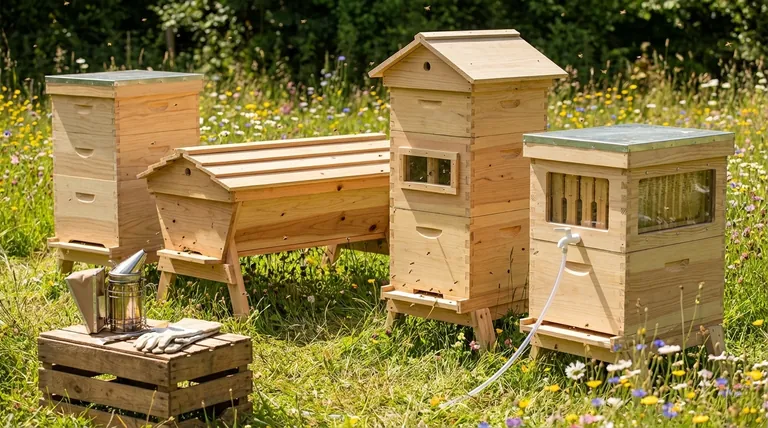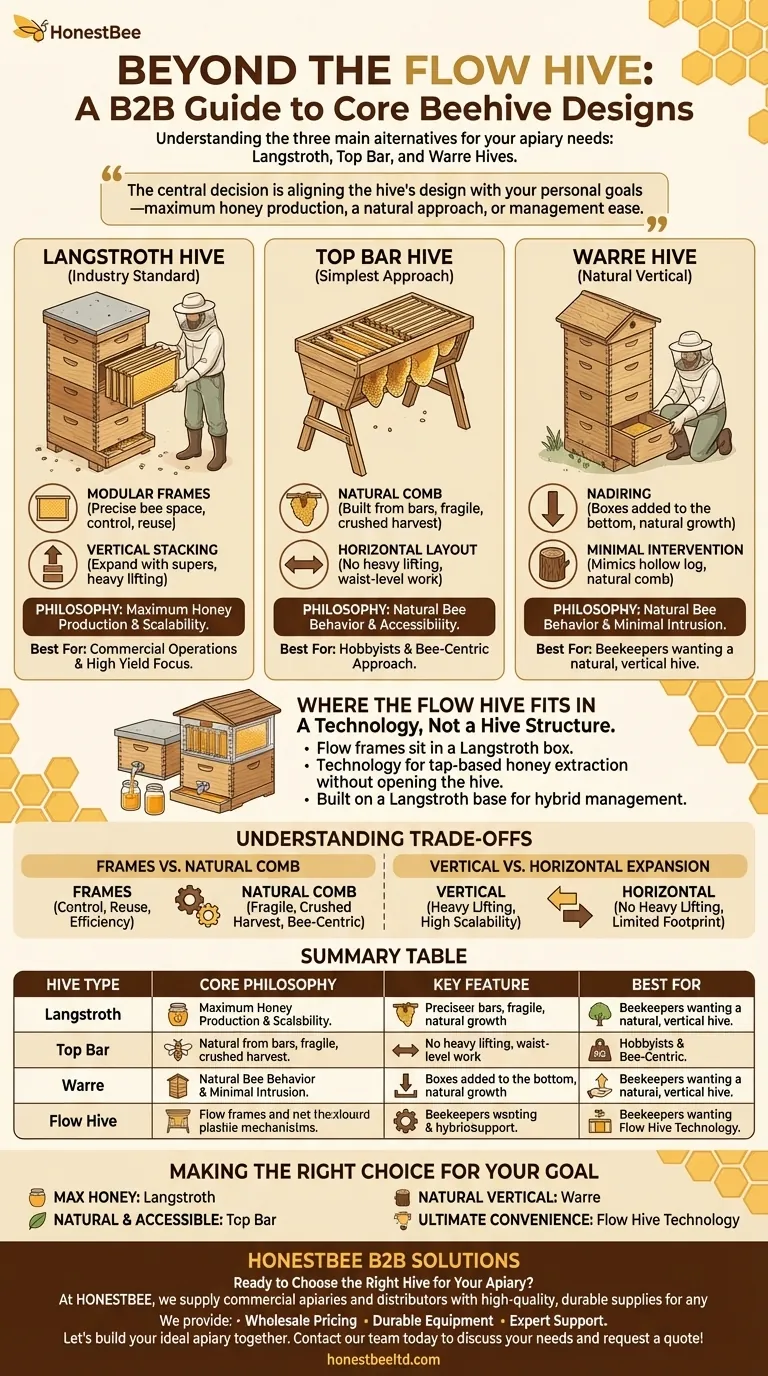Beyond the popular Flow Hive, a world of established beehive designs exists, each with a distinct philosophy and operational style. The three most common alternatives are the modular Langstroth hive, the horizontal Top Bar hive, and the vertical, "natural" Warre hive. Understanding their core differences is the first step toward choosing a hive that matches your beekeeping goals.
The central decision in choosing a beehive is not about which is "best," but about aligning the hive's design with your personal goals—whether you prioritize maximum honey production, a more natural and less interventionist approach, or physical ease of management.

Understanding the Core Hive Designs
While the Flow Hive is a recent innovation focused on honey extraction, most hive designs are defined by their fundamental structure and how bees are encouraged to build their home. These designs fall into two main categories: vertical (stacking) and horizontal (long).
The Langstroth Hive: The Industry Standard
The Langstroth is the most recognizable beehive in the world. It consists of a series of vertically stacked, interchangeable boxes.
Its key feature is the removable frame. These frames provide a structure for the bees to build their comb on and maintain a precise "bee space" around them, which prevents the bees from gluing everything together.
This modularity makes it the standard for commercial operations and beekeepers focused on maximizing honey production. It allows for easy inspection, manipulation of the colony, and expansion by simply adding more boxes (supers) on top.
The Top Bar Hive: The Simplest Approach
The Top Bar hive is a single, long horizontal box covered with simple bars of wood. Bees build their comb naturally, hanging down from these removable bars.
There are no heavy boxes to lift. All inspections and harvesting happen by working your way down the hive one bar at a time. This design is often favored by hobbyists who want a more "bee-centric" experience and have physical limitations that make lifting heavy boxes difficult.
Because it doesn't use pre-made foundation, it promotes natural comb building. Honey is typically harvested by cutting the comb from the bar, then crushing and straining it.
The Warre Hive: The "Natural Beekeeping" Vertical
The Warre (pronounced war-RAY) hive attempts to mimic the hollow log that bees would naturally inhabit. It is a vertical hive, but with a philosophy that is nearly opposite to the Langstroth.
Instead of adding boxes to the top, new boxes are added to the bottom—a process called "nadiring." This allows the colony to grow downwards naturally, keeping the heat of the brood nest at the top.
The Warre is designed for minimal intervention. Like the Top Bar, it typically uses simple bars to encourage natural comb building and is favored by beekeepers who prioritize natural bee behavior over high honey yields.
Where the Flow Hive Fits In
It is crucial to understand that the Flow Hive is not a fundamental hive type like the others, but rather a revolutionary technology for honey extraction.
A Technology, Not a Hive Structure
The "Flow" part of the hive refers to specialized plastic frames that sit in a standard hive box (a super). These frames contain partially formed honeycomb cells.
When the cells are full, a beekeeper inserts a key and turns it. This action splits the cells vertically inside the frame, creating channels that allow the honey to flow down and out of the hive through a tap, all without opening the hive or disturbing the bees.
Built Upon the Langstroth Standard
Most Flow Hives are built using Langstroth-compatible boxes. This means a beekeeper manages the lower "brood box" (where the queen lays eggs) exactly like a standard Langstroth hive. The Flow technology is only used in the honey supers above.
This creates a hybrid system, combining traditional Langstroth colony management with a highly convenient, low-disturbance method of harvesting.
Understanding the Trade-offs
Your choice of hive directly impacts how you will interact with your bees and what your primary focus will be.
Frames vs. Natural Comb
Frames, used in Langstroth hives, offer control. The comb is supported, can be easily inspected, and can be reused after honey extraction. This saves the bees immense energy.
Natural comb, encouraged in Top Bar and Warre hives, is more fragile and cannot be spun in a centrifugal extractor. It is typically crushed to release the honey, meaning bees must rebuild it from scratch each season. However, many believe this is a more natural way for bees to live.
Vertical vs. Horizontal Expansion
Vertical hives (Langstroth, Warre) require you to lift heavy boxes, which can weigh over 50 pounds (23 kg) when full of honey. This is a significant physical demand.
Horizontal hives (Top Bar, Long Langstroth) eliminate heavy lifting. All management is done at waist level, making beekeeping far more accessible to people of all physical abilities. Their downside is a finite footprint that is less scalable for large operations.
Honey Production vs. A "Bee-Centric" Philosophy
The Langstroth is unapologetically designed for the beekeeper's convenience and for maximizing honey production.
The Warre and Top Bar hives are designed to prioritize the bees' natural behaviors. They require less frequent intervention but also typically yield less honey and require different management skills.
Making the Right Choice for Your Goal
Ultimately, the hive you choose should be a tool that helps you achieve your specific beekeeping ambitions.
- If your primary focus is maximum honey production and scalability: The Langstroth hive is the unmatched industry standard for a reason.
- If your primary focus is a natural, low-intervention approach with no heavy lifting: A Top Bar or other horizontal hive is your best choice.
- If your primary focus is a balance of "natural" beekeeping with the benefits of vertical expansion: The Warre hive offers a compelling middle ground.
- If your primary focus is the ultimate convenience in honey harvesting with less disruption to the bees: The Flow Hive technology, built on a Langstroth base, is designed specifically for this purpose.
The best hive is the one that aligns with your personal beekeeping philosophy and physical capabilities.
Summary Table:
| Hive Type | Core Philosophy | Key Feature | Best For |
|---|---|---|---|
| Langstroth | Maximum Honey Production | Removable frames in vertical, stackable boxes | Commercial beekeepers, maximizing yields |
| Top Bar | Natural, Low-Intervention | Natural comb on horizontal bars; no heavy lifting | Hobbyists, accessibility, bee-centric approach |
| Warre | Natural Vertical Expansion | Boxes added to the bottom (nadiring); minimal intrusion | Beekeepers wanting a natural, vertical hive |
| Flow Hive | Harvesting Convenience | Technology for tap-based honey extraction on a Langstroth base | Beekeepers prioritizing low-disturbance harvesting |
Ready to Choose the Right Hive for Your Apiary?
Selecting the ideal hive is a critical first step toward a successful and rewarding beekeeping operation. At HONESTBEE, we supply commercial apiaries and beekeeping equipment distributors with the high-quality, durable supplies needed to build and manage any hive system—from Langstroth components to Top Bar hive kits.
We help you succeed by providing:
- Wholesale Pricing: Competitive rates for commercial-scale operations.
- Durable Equipment: Hive components built to last season after season.
- Expert Support: Guidance on the best equipment for your specific goals.
Let's build your ideal apiary together. Contact our team today to discuss your needs and request a quote!
Visual Guide

Related Products
- Australian Langstroth Beehive Boxes for Beekeeping Wholesales
- Langstroth Bee Hives Bee Keeping Box for Beginners Beekeeping
- Long Langstroth Style Horizontal Top Bar Hive for Wholesale
- HONESTBEE Professional Multi-Functional Hive Tool with Ergonomic Wood Handle
- Multi-Function Plier-Style Frame Grip Hive Tool
People Also Ask
- How many deep hive bodies should I use? The Standard for a Healthy, Winter-Ready Colony
- What is the purpose of reversing brood chambers in the spring? A Proactive Swarm Prevention Strategy
- How many frames fit into a standard beehive box? Choose Between 8-Frame and 10-Frame Hives
- What are the three types of beehives? Find the Perfect Hive for Your Beekeeping Philosophy
- What are beehive boxes, and what are they used for? The Essential Guide to Hive Components



















